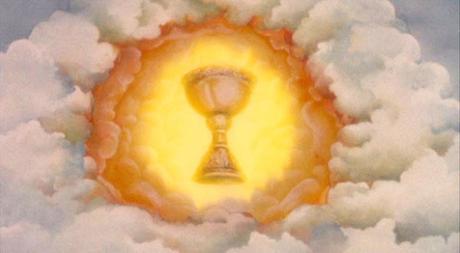
As we close in on the end of the year, it means we're soon to be swamped with a variety of "best of" lists. This website is no different ... although a little.
In the last two years, I've created my own unscientific, objective-as-possible best beer lists analyzing the compiled efforts of others scattered across the internet. You can still read 2014 and 2015 results to find out which "best" beers you might've missed.
With my attention shifting in that direction in recent weeks, I've decided to get a head start in another corner of "best," taking a look at ratings, style and rarity. As we've seen in the past, all three seem to be linked, and I've turned to two popular beer rating websites to gain a better understanding. First up: Beer Advocate.
What follows is a breakdown of Beer Advocate's top 250 beers based on the status of the list on Nov. 12. While RateBeer tends to have a mostly static group of their best beers, Beer Advcoate seems a little more ebb and flow, often based on trends of the day. You can see my analysis of New England IPA as an example.
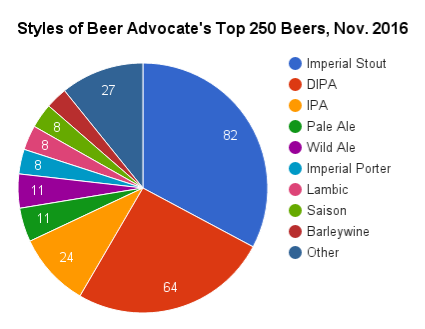
As you'd expect from such a list, it's almost completely dominated by imperial stouts and variations of IPA. In fact, 170 of the 250 are imperial stout, IPA or double IPA, a number that grows to 181 if we care to count the 11 beers that drink like IPAs but are simply masquarading stylistically as pale ales. The "other" category includes 11 styles of beer that had six or fewer beers on the list, including Eisbock (1), Berliner weisse (2), quad (4) and gueuze (6).
Alcohol content is often discussed ( including on this blog) as part of consideration when it comes to "best" beers. Typically, that's because it's connected to other aspects of a beer, whether it be style, as seen with the prominence of high-ABV stouts and IPAs above, or rarity.
To further analyze the set of beers from Beer Advocate, I took all of the top 250 beers and placed them into seven ABV ranges. Of note, five beers on the list did not have ABVs listed, nor could I easily find them online. In each case, it appears it's because of being a one-off beer with the content not being publicly shared.
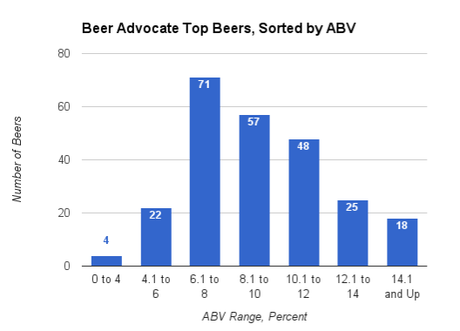
An interesting curve, mostly driven by IPAs and DIPAs in the 6.1 to 8 and 8.1 to 10 range. No surprise here, as New England IPA (specifically, Tree House) dominate those portions of the chart.
A more interesting way to take this data is then to add in the ratings provided by Beer Advocate users to find out where the truly "best" beers are found. For each ABV section mentioned above, I averaged the weighted rank of all beers, which offered this result:
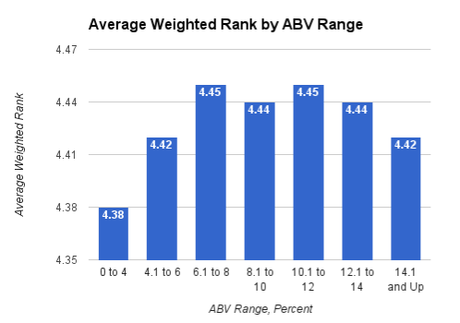
For the most part, all the beers across every ABV category are essentially perceived at the same quality.
But when we're discussing best beers, we better use those examples, right?
From there, I took the top-10 rated beers in every ABV section - the best of the best - and once again pulled the averaged weighted rank for each set. Now we have some differentiation:
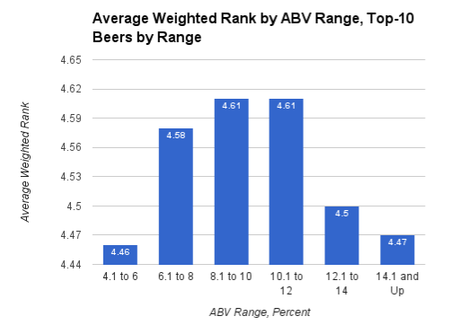
Once again, it's those New England IPAs that are pushing up the scores for beers between 6.1 and 10 percent ABV, likely aided by the rarity of actually getting a Tree House beer in your hands. Based on this singular analysis alone, you'd think Tree House was the best brewery in the country, uncontested. Maybe they are, but as we've seen before, the idea of rarity and difficulty of getting a beer is an important aspect to consider.
To that end, I did a quick "WHALEZ" check for the top 10 of each section, which revealed that eight to 10 of each list of 10 were beers that require standing in a line for hours or, at a minimum, a blood sacrifice. Some brands like Pliny the Elder or Heady Topper are certainly able to be procured, but some effort is still needed.
The stranglehold of imperial stout and IPA is emphasized when you compare these styles to others on Beer Advocate's list.
From the total 250, I pulled a collection from the 245 that had their ABV listed. I then used the averaged weighted rank for any style that had four or more beers, leaving me with 232 beers across 10 styles. For the purposes of this example, I put IPA, DIPA and those hopped-to-heaven pale ales in the same category - the weighted rank actually stayed the same whether they were all in one or separated between IPA/DIPA and pale ale.
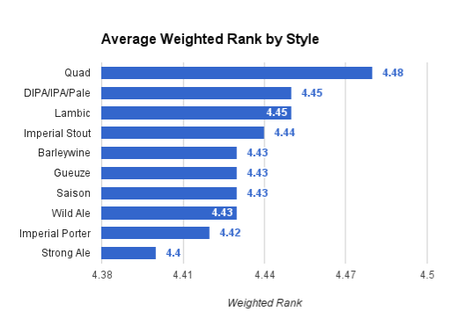
Again, the ratings of these beers are evenly split with four quads (St. Bernardus Abt 12, Westvleteren 12, Rochefort 10, Firestone Stickee Monkee) actually scoring the highest averaged rank. That might be expected, however, due to the effort one would have to go through in order to acquire those beers.
But this type of listing is somewhat expected when the imperial stout (79) and IPA/DIPA/pale ale (99) categories represent 76.7% of all the beers included in this data set.
To try and "normalize" a bit, I then took the top-10 beers from both the imperial stout and IPA/DIPA/pale ale categories to even out the number of beers included in each grouping. The chart changes quite a bit afterward:

Not even close.
For reference, here are those top-10, best beers American breweries can offer, as determined by Beer Advocate users:
Alchemist Heady Topper
Tree House Good Morning
Tree House King Julius
Toppling Goliath Kentucky Brunch
Tree House Very Hazy
Toppling Goliath Mornin' Delight
Russian River Pliny the Younger
Cigar City Double Barrel-Aged Hunaphu
Tree House King JJJuliusss
3 Floyds Bourbon Barrel Aged Vanilla Bean Dark Lord
Maine Beer Dinner
Founders Canadian Breakfast Stout
Tree House Julius
Bottle Logic Fundamental Observation
Tree House Juice Machine
Perennial Barrel-Aged Abraxas
Russian River Pliny the Elder
Goose Island Bourbon County Coffee Stout
Tree House Very Green
Founders Kentucky Breakfast Stout
This analysis is rather timely, as writer Aaron Goldfarb recently wrote this article asking the question " When Did Rarity Start to Equal Greatness in Beer? "
Aaron found that beginning around 2003, the top beers listed on Beer Advocate started to share the trait of rarity, an aspect that hasn't changed since:
The greatness of rare beer became self-fulfilling. Drive all the way across the country to Munster, Indiana, or queue up for hours in Vermont to land some Heady Topper, and how could the resulting beer not be stellar? Fetishization quickly became a fast-track to the top.
A similar conclusion was recently reached by Eno Sarris at Beergraphs when examining the potential impact of brewery acquisitions on perceived value.
Even though Beer Advocate's list of 250 best beers may fluctuate with new additions here or there, it's still compiled of brands that take time, patience and, quite often, a bit of money to procure. The raters on Beer Advocate aren't Average Joe or Jane Drinker, which can lead to the inclusion of so many beers a normal beer lover would never even see with their own eyes.
It also reinforces what kind of beers people will go crazy for, with high-ABV stouts and orange juice-IPA leading the charge. Would a limited release lager get as much love? Not likely. It may be fair to assume that only rarity isn't enough. Obviously a beer has to be good, but the act of obtaining any kind of uncommon object could be psychologically pleasing enough to boost the assumption of quality. Even still, brewers can start loading up bourbon barrels and buying oats in bulk, as those kinds of stouts and IPAs really seem to push things at the moment.
Bryan Roth
"Don't drink to get drunk. Drink to enjoy life." - Jack Kerouac

